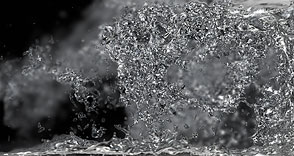© 1994-2010 Fred Fröhlich
••• FMA, Page 01
Video Installation, 2007-2008
FORMATION A
The video installation seems like a simple scenario: In a laboratory situation of sorts, a fluid is subjected to forces that produce cyclical effects. Though imperceptible for the viewer, the significantly decelerated course of movement follows mathematical laws. These principles, discovered in the 13th century, describe specific growth patterns in nature and are today also utilised by financial analysts in hope to be able to predict market developments. The fluid was simulated with digital techniques as known from visual effects in movies and commercials.
FORMATION A, HD-Video transfered to Blu-ray disc,
duration: 05:15 min, silent, infinite loop, preview
© 1994-2010 Fred Fröhlich
••• FMA, Page 02
"[...] Fröhlich's video is not about water, but rather the simulation of a fluid that has less to do with what comes out of the tap and more in common with the everyday images presented to us in TV commercials and the special effects we see in movies. Cameras struggle to capture the beauty and exact vérité of a stream of milk flowing into a bowl of cereal or a Tsunami washing over Manhattan. Software programmes, by contrast, imbue such scenes with a reality more real than real. The whole spectrum of parameters in the virtual world of filmic simulation is at the disposal of the artist striving to create the image of what it is visually expected. [...]
Upon closer examination of Fröhlich's video, it becomes clear that the alleged water must be in some kind of aquarium. [...] In this world, it is sufficient for computer- generated vortexes to move the surface of the water. The laws governing the form the waves are created in were discovered by the Italian mathematician Leonardo da Pisa, known as Fibonacci (figlio di Bonacci, son of Bonacci), in the 13th century. His numerical sequence consists of a series in which each member is the sum of the two numbers preceding it (1, 1, 2, 3, 5, 8, 13, etc.). This type of series is seen in the growth pattern of snail shells and in the spiral formation of seeds during the inflorescence of sunflowers.
The Fibonacci sequence also forms the basis of wave theories employed to analyse the economic and financial world. Ralph Nelson Elliott developed principles in the 1930s that were designed to explain stock movements on the Dow Jones. Five waves form a cycle. This cycle is corrected with three waves. [...] The mathematical relations between the waves are determined by the golden mean or the relation 0.618, a relation that corresponds to the division between two sequential numbers in the Fibonacci sequence, e.g., 3 divided by 5.
The everyday phenomena Fröhlich is seeking thus seem much more ubiquitous than was previously assumed. If there is a strange similarity between the seemingly natural wave movements of water and the cyclical dynamic of the stock market, then these waves of water reflect not only mathematical laws within a natural growth process - which Fröhlich shows, but also the phenomena of mass psychology, the expression of which is not only limited to the undulations of markets."
Text: Ronald Berg (Translation: Brian Frank)
from "Exhibition Room I / The Installed Room - the Collection of the KfW Bank Group", Frankfurt/Main, 2007


© 1994-2010 Fred Fröhlich
••• FMA, Page 03
FORMATION A, HD-Video transfered to Blu-ray disc, silent, duration: 5:15 min, infinite loop, videostills



